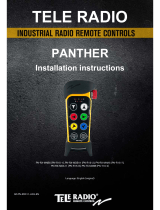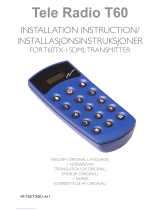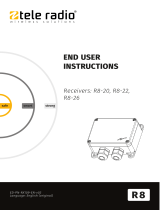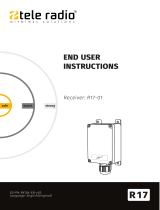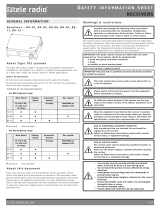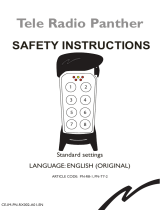
Panther
Installation instructions
IM-PN-RX105-A02-EN
Language: English (original)
Receiver PN-R18-1/2

CONTENTS
Chapter 1: CUSTOMER INFORMATION 3
Chapter 2: PRODUCT DESCRIPTION 5
Base board 5
Function LEDs indication 6
Technical data 7
Current consumption 7
Mechanical installation 8
Chapter 3: USERS' GUIDE 9
Radio mode 9
Register the transmitter in the receiver 9
Logout 9
Operating modes 10
CANopen 11
Chapter 4: GUARANTEE, SERVICE, REPAIRS AND MAINTENANCE 13
Chapter 5: REGULATORY INFORMATION 14
Chapter 6: FREQUENT TERMS 15

Chapter 1: CUSTOMER INFORMATION
CHAPTER 1: CUSTOMER INFORMATION
THANK YOU FOR PURCHASING A TELE RADIO AB PRODUCT
READALLINSTRUCTIONS ANDWARNINGS CAREFULLY BEFOREMOUNTING, INSTALLING
ANDCONFIGURATING THEPRODUCTS.
These instructions are published by Tele Radio AB and are not subject to any guarantee. The
instructions may be removed or revised by Tele Radio AB at any time and without further notice.
Corrections and additions will be added to the latest version of the instructions.
IMPORTANT! These instructions are directed to installers. The instructions containing information
about the installation and configuration of the radio remote control unit on the machine are not
intended to be passed on to the end user. Only information that is needed to operate the machine
correctly by radio remote control may be passed on to the end user.
Tele Radio AB products are covered by a guarantee/warranty against material, construction or
manufacturing faults. During the guarantee/warranty period, Tele Radio AB may replace the product or
faulty parts. Work under guarantee/warranty must be carried out by Tele Radio AB or by an authorized
service center specified by Tele Radio AB. Contact your Tele Radio AB representative if you need
support or service.
©Tele Radio AB
Datavägen 21
SE-436 32 ASKIM
SWEDEN
Tel: +46-31-748 54 60
Fax: +46-31-68 54 64
www.tele-radio.com
-3-

WARNINGS & RESTRICTIONS
WARNING! Tele Radio AB remote controls are often built into wider applications. We recommend
that the system is equipped with a wired emergency stop where necessary.
INSTALLING, CONNECTING AND MOUNTING
nOnly permit licensed or qualified personnel to install the product.
nSwitch off the power supply to the receiver before connecting the equipment.
nCheck that the power supply is connected to the correct connection terminal.
nTo utilize the safety of the system, use the stop relays in the safety circuitry of the object that you
want to control.
nDo not use damaged cables. Cables must not hang loose.
nAvoid installing in areas affected by strong vibrations.
nThe receiver withstands normal weather conditions but should be protected from extreme con-
ditions. The receiver should also not be subjected to mechanical water pressure i.e. a pressure
washer or similar adverse conditions.
nAvoid installing the receiver in a place where it will be subjected to high water flows and/or
heavy precipitation.
nCable glands and vent plugs must face downwards to prevent water from gaining access.
THE USER
nOnly permit qualified personnel to access the transmitter and operate the equipment.
nMake sure that the user follows the instructions.
nMake sure that the user satisfies the age requirements in your country for operating the equip-
ment.
nMake sure that the user is not under the influence of drugs, alcohol or medications.
nMake sure that the user does not leave the transmitter unsupervised.
nMake sure that the user always switches the transmitter off when it is not in use.
nMake sure that the user has a clear view of the work area at all times.
MAINTENANCE
nUse the stop button to start and switch off the transmitter as often as possible.
nIf error messages are shown, it is very important to find out what caused them.
nIf the stop button is mechanically damaged, contact your representative for service immediately.
nAlways contact your representative for service and maintenance work on the product.
nWrite down the serial numbers/ID codes of the receivers and transmitters used. This information
should be recorded in the “Settings document” for your product (download from our website).
nAvoid registering transmitters in receivers where they are not being used.
nKeep the safety instructions for future reference. Always download the configuration instruc-
tions from our website for the latest available version.
WEEE DIRECTIVE
This symbol means that inoperative electrical and electronic products must not be mixed
with household waste.The European Union has implemented a collection and recycling
system for which producers are responsible. For proper treatment, recovery and recycling,
please take this product to a designated collection point.
Tele Radio AB strives to minimize the use of hazardous materials, promotes reuse and recycling, and
reduces emissions to air, soil and water. When a commercially viable alternative is available, Tele Radio
AB strives to restrict or eliminate substances and materials that pose an environmental, health or safety
risk.
-4-

Chapter 2: PRODUCT DESCRIPTION
CHAPTER 2: PRODUCT DESCRIPTION
WARNING! The receiver must NOT be opened by anyone other than a qualified installer. Make sure
that the electricity is switched off before opening the receiver.
BASE BOARD
NOTE! This base board is fitted in the following receiver models:
PN-R18-1, PN-R18-2
LED 5
LED 6
LED 7
LED 8
LED 9
LED 10
LED 11
LED 12
1
2
3
4
65
7
10
9
8
1. Terminal block for input
power and CAN signals
2. Function button (cancel)
3. Select button (OK)
4. Programming connector
5. CAN error LED (red)
6. CAN run LED (green)
7. Function LEDs
(5 = red, 6 = yellow, 7 =
green,
8 = orange)
8. Indication LEDs 9–12 (red)
9. Power LED(yellow)
10. Radio module
TERMINAL BLOCK FOR INPUT POWER AND CAN SIGNALS
1
2
3
4
5
6
1. (not in use)
2. Shield
3. CAN high
4. CAN low
5. GND
6. Input power 12–
24V DC
-5-

M12 CONNECTOR
NOTE! This connector is only used on the receiver model:
PN-R18-2
1
3
4
2
5
1. Shield
2. Input power 12–24V DC
3. GND
4. CAN high
5. CAN low
FUNCTION LEDS INDICATION
LED Colour Off On Indicates
5 red x No transmitter is registered.
x Flashes once: One or more transmitters are registered. No radio trans-
mission established.
x Double flash: One or more transmitters are registered and logged in. No
radio transmission established.
x Radio transmission established.
6 yellow x Receiving a radio packet from a transmitter other than a Panther.
6
7
yellow
green
x Receiving a radio packet from a transmitter set to the radio mode different
from that of a receiver.
6
8
yellow
orange
x Receiving a radio packet from a transmitter that is not registered.
7 green x Receiving a radio packet, low signal (RSSI).
8 orange x Receiving a radio packet, configuration ID not accepted.
7
8
green
orange
x Receiving a radio packet, custom ID not accepted.
6
7
8
yellow
green
orange
x 1. Receiving a radio packet from a registered transmitter. The receiver is
already controlled by another registered transmitter. NOTE! "Radio link"
must be activated in the receiver.
2. Load select mode is activated. Incorrect Load is selected on the
transmitter.
-6-

TECHNICAL DATA
Input power 12–24V DC
Digital inputs 0
Radio communication Simplex
Max. number of registered transmitters 8
IP code 65
Dimensions 80 x 54 x 38 mm / 3 x 2 x 1.5 in
Weight Max. 200 g / 0.44 Ibs
Operating temperature -20 – +55 °C / -4 – +130 °F
Frequency band 2405–2480 MHz
Number of channels 16 (channel 11–26)
Antenna Internal antenna
Field bus communication Support for CANopen
CURRENT CONSUMPTION
Input power Typical*
12V DC 0.05A
24V DC 0.02A
*Receiver powered and CAN communication active
-7-

MECHANICAL INSTALLATION
87 mm (3.4 in)
96 mm (3.8 in)
Ø
4 mm (0.16 in)
38 mm (1.5 in)
54.1 mm (2.1 in)
44 mm (1.7 in)
Cable diameter
3.5–10 mm (0.14–0.39 in)
-8-

Chapter 3: USERS' GUIDE
CHAPTER 3: USERS' GUIDE
RADIO MODE
NOTE! The radio mode is determined by the selected Operating mode. To establish a radio link
between the transmitter and receiver, both units need to be set to the same radio mode.
This receiver is set to discontinuous radio mode by default.
REGISTER THE TRANSMITTER IN THE RECEIVER
WARNING! Only keep the transmitters that you intend to use registered in the receivers.
NOTE! To establish a radio link between the transmitter and the receiver, both units must be set to the
same radio mode.
NOTE! The registration procedure for PN-R18-1/2 differs compared to other Panther receivers.
1. Set the transmitter in registration mode (see relevant Tele Radio Transmitter Installation instruc-
tions).
2. Press the receiver Function button
The function LED lights (red).
3. Press the receiver Select button
All indication LEDs light (red).
4. Activate the registration procedure from the transmitter (see relevant Tele Radio Transmitter
Installation instructions).
All function LEDs and indication LEDs light. All function LEDs and indication LEDs flash 2 times.
5. Release the transmitter buttons.
All function LEDs and indication LEDs flash 1 time.
The transmitter is registered.
If no transmitter is found within approximately 10 seconds, the receiver exits to normal operation.
LOGOUT
NOTE!You cannot activate/deactivate the logout function in the receiver. Contact your representative
for assistance.
For this receiver the logout function is deactivated by default.
For the logout function to work, the receiver must be set to continuous radio mode.
-9-

OPERATING MODES
Select Operating mode
1. Press the Function button 4 times.
Function LED 8 lights (orange).
2. Press the Select button to see the Operating mode in use.
The indication LEDs light (red) according to the table below, function LED 8 flashes (orange).
When indication LED no. lights... the selected Operating mode is...
1 1 Discontinuous radio mode (default)
2 2 Continuous radio mode
3. Press the Function button to move to the next available Operating mode.
4. Press the Select button to select Operating mode.
The receiver exits the Operating mode menu and restarts.
-10 -

CANOPEN
Show/change CANopen node ID
CANopen node IDs from 1–15 can be selected from the receiver user interface. Any value greater than
15 will be shown as 15 on the receiver user interface.
NOTE! When setting CANopen node IDs greater than 15, please contact your representative.
1. Press the Function button twice.
Function LED 6 lights (yellow) and indication LEDs 9–12 (red) show the current CANopen
node ID according to the table below.
2. Press the Select button.
The indication LEDs 9–12 (red) show the current CANopen node ID according to the following
table and function LED 6 flashes (yellow).
When indication LED no. lights… the selected CANopen node ID is…
12 1 (default)
11 2
11 + 12 3
10 4
10 + 12 5
10 + 11 6
10 + 11 + 12 7
9 8
9 + 12 9
9 + 11 10
9 + 11 + 12 11
9 + 10 12
9 + 10 + 12 13
9 + 10 + 11 14
All 15
3. Press the Function button to move to the next available CANopen node ID.
4. Press the Select button to select the CANopen node ID.
The receiver exits the menu and restarts.
-11 -

SHOW/CHANGE CAN BITRATE
1. Press the Function button three times.
Function LED 7 lights (green) and indication LEDs 9–12 (red) show the current CAN bitrate
according to the table below.
2. Press the Select button.
The indication LEDs 9–12 (red) show the current CAN bitrate according to the following table
and function LED 7 flashes (green).
When indication LED no. lights… the selected CAN bitrate is…
0 1000 kbps
12 800 kbps
11 500 kbps
11 + 12 250 kbps (default)
10 125 kbps
10 + 12 100 kbps
10 + 11 50 kbps
10 + 11 + 12 20 kbps
9 10 kbps
3. Press the Function button to move to the next available CAN bitrate.
4. Press the Select button to select the CAN bitrate.
The receiver exits the menu and restarts.
NOTE! For further information about the CANopen implementation in this receiver, for CANopen
programmer's instructions and/or for EDS-file, contact your representative.
-12 -

Chapter 4: GUARANTEE, SERVICE, REPAIRS AND MAINTENANCE
CHAPTER 4: GUARANTEE, SERVICE, REPAIRS AND
MAINTENANCE
Tele Radio AB products are covered by a guarantee/warranty against material, construction and
manufacturing faults. During the guarantee/warranty period, Tele Radio AB may replace the product or
faulty parts. Work under guarantee/warranty must be carried out by Tele Radio AB or by an authorized
service centre specified by Tele Radio AB.
The following are not covered by the guarantee/warranty:
nFaults resulting from normal wear and tear
nParts of a consumable nature
nProducts that have been subject to unauthorized modifications
nFaults resulting from incorrect installation and use
nDamp and water damage
Maintenance:
nRepairs and maintenance must be carried out by qualified personnel
nUse spare parts from Tele Radio AB only
nContact your representative if you require service or other assistance
nKeep the product in a dry, clean place
nKeep contacts and antennas clean
nWipe off dust using a slightly damp, clean cloth
WARNING! Never use cleaning solutions or high-pressure water.
-13 -

Chapter 5: REGULATORY INFORMATION
CHAPTER 5: REGULATORY INFORMATION
CE MARKING
This product is in compliance with the essential requirements of directive 1995/5/EC of the European
Parliament and of the Council. Latest version of the EC Declaration of Conformity can be downloaded
from the Tele Radio AB website, www.tele-radio.com.
-14 -

Chapter 6: FREQUENT TERMS
CHAPTER 6: FREQUENT TERMS
Configuration ID Numerical code stored in both the transmitter and receiver unit. The receiver unit
can only be controlled by a transmitter with the correct configuration ID.
Continuous radio
mode
When in continuous radio mode the transmitter unit transmits continuously when
it is switched on.
Custom ID Numerical code stored in the transmitter unit, used to replace the unique ID code.
One or several transmitter units can be configured with the same custom ID and
the receiver will recognise them all as the same transmitter unit.
Discontinuous radio
mode
When in discontinuous radio mode the transmitter unit transmits whenever it is
switched on and a button is pressed. The transmission is interrupted when all but-
tons are released.
Function relay Standard relay, controlled by the buttons on the transmitter unit.
Interlocking Prevents a component from functioning when another component is functioning
or operating in a particular way.
Latching relay
functionality
The relay becomes active every time you press a button and remains active until
the button is pressed again.
Load select mode One or more Load select modes are stored in the transmitter unit. Activating a spe-
cific Load select mode results in a group of preselected relays on the receiver unit,
which may be controlled from the transmitter unit.
Momentary relay
functionality
The relay will only be active while a button is pressed on the transmitter. When
the button is released, the relay will no longer be active.
On relay Relay that is active when the receiver unit is operating and a radio link is estab-
lished, regardless of whether any other relays are active.
Operating mode One or more Operating modes are stored in the receiver unit. Each Operating
mode describes which relays on the receiver unit are controlled when specific but-
tons on the transmitter unit are pressed.
Replace ID Numerical code used to identify the transmitter during the Replace procedure.
Stop relay Safety related relay controlled by the stop button on the receiver. Intended to inter-
rupt the power supply to a safety application controlled by the receiver unit.
Work relay Relay that is active when any other specified relay(s) on the receiver unit is/are act-
ive.
Zero position check Security function ensuring that potentially active buttons/joysticks upon start up
or lost/found radio links must be in the zero position before the system can be
used to avoid unplanned movements of the controlled object.
-15 -

This installation instruction is subject to change without prior notice.
Download the latest installation instruction from www.tele-radio.com
/

